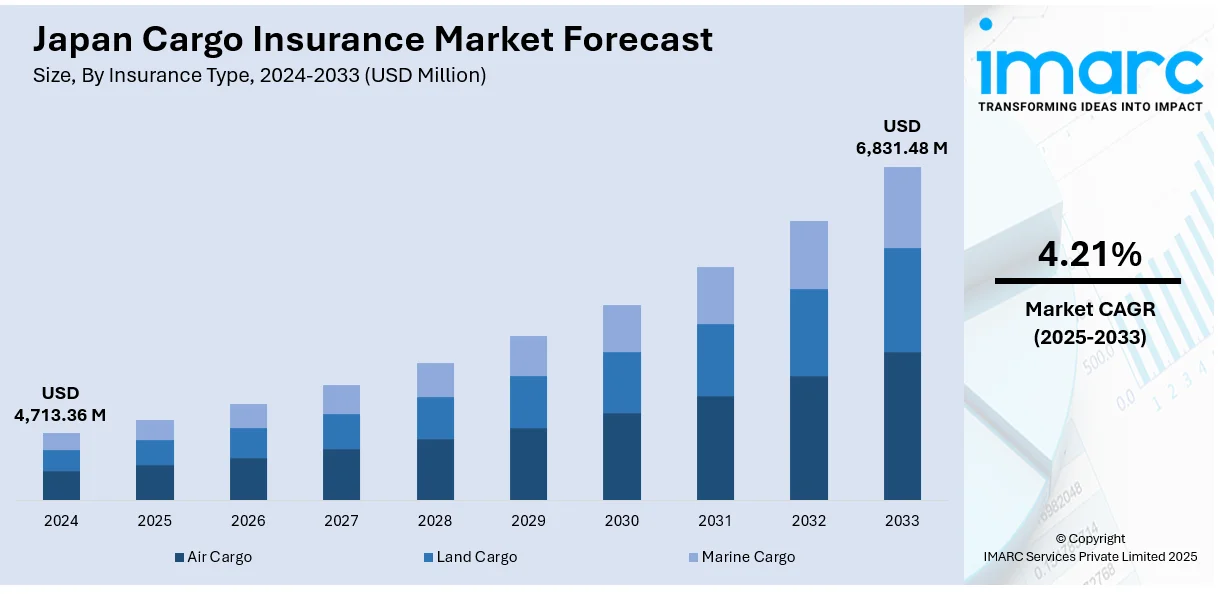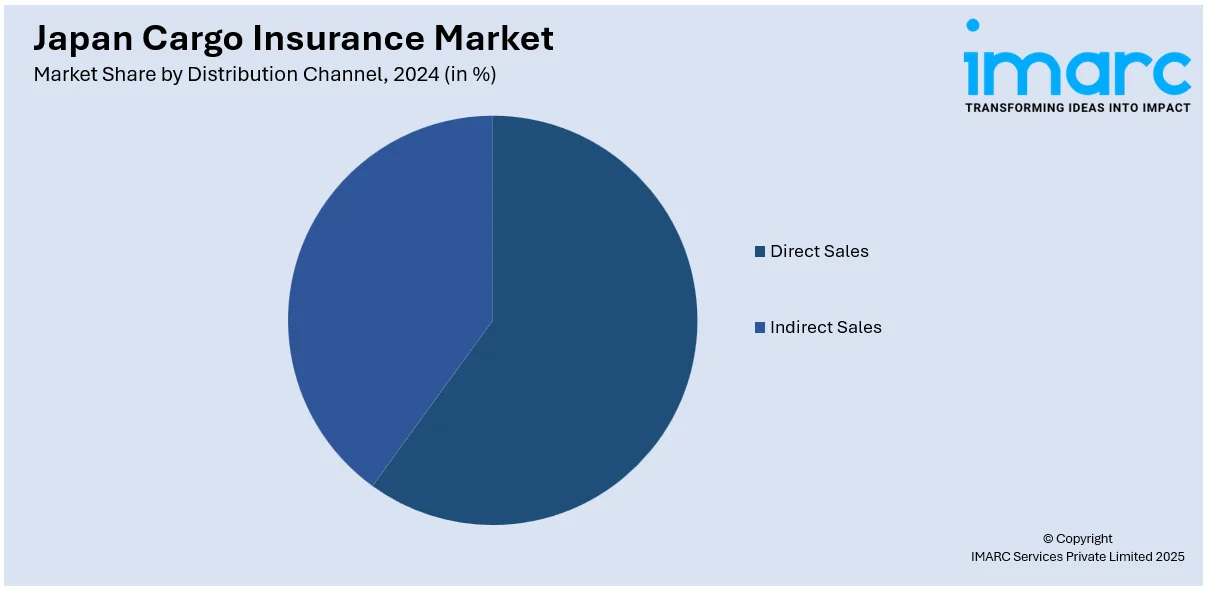
Japan Cargo Insurance Market Size, Share, Trends and Forecast by Type, Distribution Channel, End User, and Region, 2025-2033
Japan Cargo Insurance Market Overview:
The Japan cargo insurance market size reached USD 4,713.36 Million in 2024. Looking forward, IMARC Group expects the market to reach USD 6,831.48 Million by 2033, exhibiting a growth rate (CAGR) of 4.21% during 2025-2033. The continuous expansion of freight movement and trade is impelling the growth of the market. This trend, along with the increased risk awareness about supply chains, is playing a major part in bolstering the market growth. Apart from this, technological advancements and the ongoing development of digital platforms are expanding the Japan cargo insurance market share.
|
Report Attribute
|
Key Statistics
|
|---|---|
|
Base Year
|
2024
|
|
Forecast Years
|
2025-2033
|
|
Historical Years
|
2019-2024
|
| Market Size in 2024 | USD 4,713.36 Million |
| Market Forecast in 2033 | USD 6,831.48 Million |
| Market Growth Rate 2025-2033 | 4.21% |
Japan Cargo Insurance Market Trends:
Increasing Global Trade and Freight Movement
The Japan cargo insurance sector is being supported considerably by the continuous growth in freight movement and trade. Since international trade volumes are mounting, the need for transportation and logistics services is growing, which is leading businesses to acquire cargo insurance. This number of shipments, whether goods are being shipped by sea, air, or land, is constantly fueling the demand for risk mitigation solutions, especially in sectors like electronics, automotive, and manufacturing. Businesses are realizing the importance of safeguarding their goods in transit, making sure that they are insured against possible risks such as damage, theft, and natural disasters. Hence, insurance companies are observing an upward trend in policy adoption as companies seek stable coverage to secure their shipments. Consequently, the industry is accommodating more insured shipments, thereby fueling the Japan cargo insurance market growth. The IMARC Group predicts that the Japan freight logistics market is expected to attain USD 415 Billion by 2033.

Rising Awareness of Risk Management in Supply Chains
Increased risk awareness about supply chains is playing a major part in bolstering the market growth. As supply chain disruptions often occur because of unexpected circumstances like natural disasters and geopolitical tensions, companies are focusing on protecting their cargo. Firms are making investments in cargo insurance policies to counter the financial effects of possible setbacks such as damage to goods or delayed shipments. Additionally, the increasing pace of digitalization in the logistics industry is making processes more transparent and traceable, which is motivating more companies to invest in cargo insurance solutions. As companies work to secure their assets and maintain uninterrupted functioning, the market for thorough cargo insurance policies is constantly growing. This increased emphasis on controlling risks in the supply chain is generating considerable opportunities for insurers to extend their business in Japan.
Advancements in Technology and Digital Platforms
Technological advancements and the ongoing development of digital platforms are shaping the market by making insurance processes more efficient and accessible. Innovations such as Internet of Things (IoT)-enabled tracking devices, artificial intelligence (AI), and blockchain are being integrated into the cargo insurance ecosystem, offering improved monitoring, enhanced risk assessment, and streamlined claims management. These technologies are enabling insurers to provide more tailored and dynamic coverage based on real-time data, significantly reducing operational costs and increasing transparency. As digital platforms evolve, they allow businesses to easily purchase, track, and manage insurance policies online, driving convenience and accessibility. In addition, advanced data analytics is empowering insurers to better understand risk patterns, offering more precise premiums and coverage options. This technological transformation is continuously reshaping the market by meeting the growing demand for smarter, faster, and more cost-effective cargo insurance solutions. The Japan data analytics market size is projected to reach USD 12,020 Million by 2033, according to the predictions of the IMARC Group.
Japan Cargo Insurance Market Segmentation:
IMARC Group provides an analysis of the key trends in each segment of the market, along with forecasts at the country and regional levels for 2025-2033. Our report has categorized the market based on insurance type, distribution channel, and end user.
Insurance Type Insights:
- Air Cargo
- Land Cargo
- Marine Cargo
The report has provided a detailed breakup and analysis of the market based on the insurance type. This includes air cargo, land cargo, and marine cargo.
Distribution Channel Insights:

- Direct Sales
- Indirect Sales
The report has provided a detailed breakup and analysis of the market based on the distribution channel. This includes direct sales and indirect sales.
End User Insights:
- Traders
- Cargo Owners
- Ship Owners
- Others
A detailed breakup and analysis of the market based on the end user have also been provided in the report. This includes traders, cargo owners, ship owners, and others.
Regional Insights:
- Kanto Region
- Kansai/Kinki Region
- Central/ Chubu Region
- Kyushu-Okinawa Region
- Tohoku Region
- Chugoku Region
- Hokkaido Region
- Shikoku Region
The report has also provided a comprehensive analysis of all the major regional markets, which include Kanto Region, Kansai/Kinki Region, Central/ Chubu Region, Kyushu-Okinawa Region, Tohoku Region, Chugoku Region, Hokkaido Region, and Shikoku Region.
Competitive Landscape:
The market research report has also provided a comprehensive analysis of the competitive landscape. Competitive analysis such as market structure, key player positioning, top winning strategies, competitive dashboard, and company evaluation quadrant has been covered in the report. Also, detailed profiles of all major companies have been provided.
Japan Cargo Insurance Market Report Coverage:
| Report Features | Details |
|---|---|
| Base Year of the Analysis | 2024 |
| Historical Period | 2019-2024 |
| Forecast Period | 2025-2033 |
| Units | Million USD |
| Scope of the Report |
Exploration of Historical Trends and Market Outlook, Industry Catalysts and Challenges, Segment-Wise Historical and Future Market Assessment:
|
| Insurance Types Covered | Air Cargo, Land Cargo, Marine Cargo |
| Distribution Channels Covered | Direct Sales, Indirect Sales |
| End Users Covered | Traders, Cargo Owners, Ship Owners, Others |
| Regions Covered | Kanto Region, Kansai/Kinki Region, Central/ Chubu Region, Kyushu-Okinawa Region, Tohoku Region, Chugoku Region, Hokkaido Region, Shikoku Region |
| Customization Scope | 10% Free Customization |
| Post-Sale Analyst Support | 10-12 Weeks |
| Delivery Format | PDF and Excel through Email (We can also provide the editable version of the report in PPT/Word format on special request) |
Key Questions Answered in This Report:
- How has the Japan cargo insurance market performed so far and how will it perform in the coming years?
- What is the breakup of the Japan cargo insurance market on the basis of type?
- What is the breakup of the Japan cargo insurance market on the basis of distribution channel?
- What is the breakup of the Japan cargo insurance market on the basis of end user?
- What is the breakup of the Japan cargo insurance market on the basis of region?
- What are the various stages in the value chain of the Japan cargo insurance market?
- What are the key driving factors and challenges in the Japan cargo insurance?
- What is the structure of the Japan cargo insurance market and who are the key players?
- What is the degree of competition in the Japan cargo insurance market?
Key Benefits for Stakeholders:
- IMARC’s industry report offers a comprehensive quantitative analysis of various market segments, historical and current market trends, market forecasts, and dynamics of the Japan cargo insurance market from 2019-2033.
- The research report provides the latest information on the market drivers, challenges, and opportunities in the Japan cargo insurance market.
- Porter's five forces analysis assist stakeholders in assessing the impact of new entrants, competitive rivalry, supplier power, buyer power, and the threat of substitution. It helps stakeholders to analyze the level of competition within the Japan cargo insurance industry and its attractiveness.
- Competitive landscape allows stakeholders to understand their competitive environment and provides an insight into the current positions of key players in the market.
Need more help?
- Speak to our experienced analysts for insights on the current market scenarios.
- Include additional segments and countries to customize the report as per your requirement.
- Gain an unparalleled competitive advantage in your domain by understanding how to utilize the report and positively impacting your operations and revenue.
- For further assistance, please connect with our analysts.
 Request Customization
Request Customization
 Speak to an Analyst
Speak to an Analyst
 Request Brochure
Request Brochure
 Inquire Before Buying
Inquire Before Buying




.webp)




.webp)












